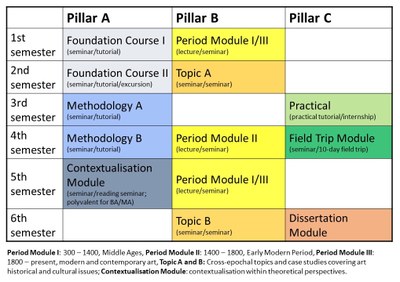Bachelor of Arts
Initial Information:
During the degree programme History and Culture (BA), Art History can be studied as a major or a minor in its thematic scope as well as historic depth. Art History can be studied as a:
- First major subject (80 CP + thesis)
- Second major subject (70 CP)
- First minor subject (40 CP)
- Second minor subject (30 CP)
The modules offered are divided into three pillars:
- A: Fundamentals of the subject (Modules: Foundation Course, Methodology, Contextualisation)
- B: The subject in its historic depth (Period Modules: I. 300-1400: Middle Ages, II. 1400-1800: Early Modern Period, III. Modernism and the Present) and thematic scope (Topics A and B)
- C: Practical Studies (Practice Module, i.e., internships, field trips, thesis)
Programme Start: Every winter term. Application deadline: 15 July.
Programme Contents:
Art History at JLU Giessen is a long-standing academic discipline. Today, the subject offers an undergraduate education which encompasses knowledge and research in art and architectural history as well as visual studies. The degree programme imparts methodological knowledge for working in art history and visual studies, on the diversity of issues and possibilities of contextualisation of architecture, art object, and paintings as well as exemplary and thematically focused foundational knowledge on art historical periods and categories, ranging from the Middle Ages to contemporary times.
During your course of study, you will learn about the creation conditions, aesthetic properties, functions and perceptions of paintings, art objects and constructed spaces within the European and younger North American culture. Through foundation and topical modules, the undergraduate degree fosters an understanding for past and present notions of what art is. In addition, visual cultures, i.e., practices and techniques of seeing as well as forms of perception and mediation are part of the studies. This offers various points of connection to current issues in cultural studies and to existing teaching and research contexts at JLU in both the fields of visual media and visuality.
Through the incorporation of different study methods (e.g., research in libraries and library databases, writing texts for various target audiences, presentations in front of an audience), you will be equipped for the communicative and technical requirements of your future professional life. Practical knowledge will be taught during field trips and internships as well as during tutorials which are offered by teaching staff with professional experience in the respective field.
Prerequisites:
As a student of Art History, you should be interested in the historical classification, aesthetic quality and social significance of paintings, buildings and art objects. As this subject has a strong cultural studies orientation, you should not only enjoy detailed and analytical observation but also reading (e.g., literature on the respective period; scholarly literature).
The version of the examination regulations valid at the start of your studies contains information on the required language skills and how to prove them.
Career Options:
This degree programme qualifies you for a broad spectrum of professions concerned with art and culture. Against the backdrop of today’s culture which is characterised by medial diversity, you will acquire critical-analytical skills to deal with the production, meaning and the contexts of visual culture. Traditional fields of work in art history include museums and the exhibition sector, heritage preservation, research and documentation. Furthermore, employment in cultural, educational and touristic institutions as well as in journalism or publishing is possible.
A detailed and constantly updated overview of fields of work and an assessment of career prospects can be found here:
- Portal of the Association of German Art Historians (Verband Deutscher Kunsthistoriker e.V.)
- Kunstgeschichte.info / an online guide for art historians
Further Information:
-
Overview of the Special Examination and Study Regulations of the degree programme History and Culture (BA) and the module descriptions and module plans (english version available)
- A catalogue of all courses of the current or past semester(s) can be found in the electronic course catalogue (elektronisches Vorlesungsverzeichnis (eVV))
- General information on the application and admissions process can be found on the Internaional Pages of JLU
